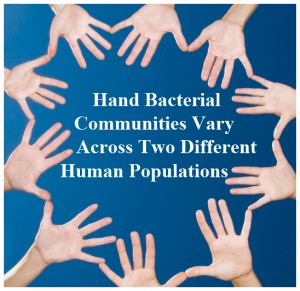There is an interesting and important paper out in Microbiology: Hand Bacterial Communities Vary Across Two Different Human Populations by Denina Hospodsky, Amy J. Pickering, Timothy R. Julian , Dana Miller, Sisira Gorthala, Alexandria B. Boehm, and Jordan Peccia. This paper is important for many reasons including the following:
- They found significant variation in the communities found on the hands of people from Tanzania vs. those from the US
- The study focused on the hands of women – this is in particular interesting in light og the recent call for more research using females as study subjects in animals. See for example this NY Times article Labs Are Told to Start Including a Neglected Variable: Females
- The paper is one of only a few where the human skin microbiome has been compared in detail between human populations.
- The authors point out that “Future work should investigate causal mechanisms influencing the hand microbiome with a focus on documentation of relative abundances of organisms that are derived from contact with the environment versus organisms that are part of the active microbial ecology.” Thus studies of the hand microbiome are perhaps in particular connected to the microbiome of the environment where people spend their time.
Anyway – definitely worth a look

Important article for many reasons. among them that it points out the danger of over-generalizing, a common tendency for researchers. The comparison between U.S. and Tanzanian women’s hands showed that results from those studies on the human skin microbiome done in the U.S. should be recognized as potentially limited to the context in which they were done.
In my opinion, this limitation should be more widely considered in the interpretation and reporting results of indoor microbiome research
Peccia’s group has published papers on the influence of human’s on the indoor microbiome. Since it is possible (maybe likely?) that a significant fraction of the human-source microbes found indoors are from the skin, it should be noted that what is found in one population may not be generalizable.
It will be interesting to see the results from Maria-Gloria Dominguez Bello’s Sloan funded research on the indoor microbiome in homes at various levels of cultural evolution in three communities in Peru.